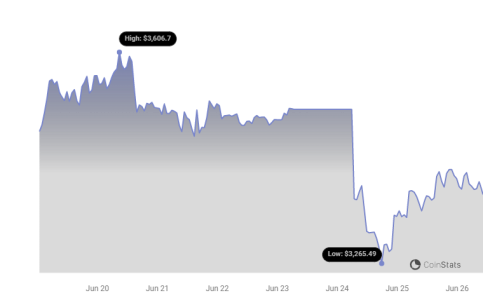Robert Kiyosaki Predicts Bitcoin Surge Amid Market Skepticism
Financial educator Robert Kiyosaki and trader Willy Woo recently exchanged views on Bitcoin's future, highlighting its underlying principles and potential growth. Meanwhile, seasoned trader Peter Brandt shared insights from Jack Mallers' BTC Prague speech on Bitcoin's proof-of-work mechanism and decentralization. Additionally, U.S.-listed Bitcoin exchange-traded funds experienced substantial outflows.
Robert Kiyosaki Predicts Bitcoin Surge Amidst Market Skepticism; Willy Woo Highlights Key Sign for Bitcoin’s Peak
Renowned financial educator and author of the bestselling finance book “Rich Dad Poor Dad,” Robert Kiyosaki, has once again stirred the crypto community with a bold prediction about Bitcoin. In a recent tweet, Kiyosaki expressed frustration over the reluctance of individuals to invest in Bitcoin, attributing it to what he termed as “lame excuses.”
Despite its current high trading value, Kiyosaki remains bullish, forecasting even greater heights for the world's flagship cryptocurrency. Engaging in a dialogue with Kiyosaki, trader and entrepreneur Willy Woo provided insight into when Bitcoin's upward trajectory might plateau, suggesting that Bitcoin is still in its ascent phase.
Kiyosaki's Bold Bitcoin Prediction
Kiyosaki's tweet revealed his exasperation with people's hesitation to buy Bitcoin. He noted that many deem BTC too expensive, failing to seize the opportunity due to its high price point. Despite this, Kiyosaki emphasized that Bitcoin’s current value is not its peak. He quoted his famous book, stating, “Your profit is made when you buy…Not when you sell.” Reflecting on past opportunities, Kiyosaki lamented that the days of purchasing Bitcoin at $10 are long gone, yet he firmly believes in its potential to climb further.
A week prior to his tweet, Kiyosaki made waves with a stunning price prediction for Bitcoin, asserting that it could soar to $350,000 by mid-August or at some point in 2024. He clarified that this is not a guaranteed prediction but his personal opinion. Kiyosaki revealed his continued investment in Bitcoin, Ethereum, and Solana, driven not by unwavering faith in these digital currencies but by a profound mistrust of the current U.S. government and its fiscal policies.
Willy Woo's Insight on Bitcoin's Peak
Responding to Kiyosaki’s optimistic forecast, trader and crypto entrepreneur Willy Woo engaged in a Twitter dialogue, shedding light on a critical sign for Bitcoin's eventual peak. Woo pointed out that Bitcoin’s bull run would conclude when widespread investment is achieved. He highlighted that currently, only 4.7% of the available capital in the market has been invested in Bitcoin by financial institutions, indicating substantial room for growth.
Bitcoin’s Current Market Dynamics
The dialogue between Kiyosaki and Woo comes at a time when Bitcoin is experiencing significant volatility. The cryptocurrency market, known for its rapid price fluctuations, has seen Bitcoin trading at relatively high levels, sparking both enthusiasm and skepticism among investors. Kiyosaki’s bullish stance indicates a broader sentiment among some financial experts who view Bitcoin as a hedge against economic instability and governmental fiscal mismanagement.
However, the reluctance of many to invest in Bitcoin, as noted by Kiyosaki, reflects the ongoing debate about the cryptocurrency’s value and future potential. The high entry price and perceived risks associated with digital currencies continue to deter a segment of potential investors.
As Bitcoin continues to capture headlines and dominate financial discussions, the contrasting views of Kiyosaki and Woo offer valuable perspectives for investors. Kiyosaki’s unwavering belief in Bitcoin’s future, coupled with Woo’s analytical approach to its market dynamics, provides a comprehensive outlook on the cryptocurrency’s potential trajectory.
While Kiyosaki’s prediction of a $350,000 Bitcoin remains speculative, it serves as a strong sign of the enduring allure of cryptocurrencies in the face of economic uncertainties. As more financial institutions consider Bitcoin as a viable investment, the market could witness significant shifts, validating Kiyosaki’s optimistic outlook or challenging the cryptocurrency’s resilience in the long term.
Peter Brandt Highlights Jack Mallers’ BTC Prague Speech on Proof of Work and Bitcoin’s Decentralized Vision
Peter Brandt, one of the most experienced traders in the field, shared an insightful video on his personal X account. The video features highlights from the recent BTC Prague event, where Jack Mallers, CEO of Strike, delivered a compelling discussion on the critical concepts of proof of work (PoW) and the decentralized peer-to-peer (P2P) network envisioned by Bitcoin’s creator, Satoshi Nakamoto.
Jack Mallers on Proof of Work and Decentralization
During his speech, Mallers delved deeply into the proof-of-work mechanism, a fundamental component of the Bitcoin network. He elucidated how PoW functions safeguard the network against double-spending, ensure consensus, and maintain security. By requiring miners to solve complex mathematical problems to validate transactions and add them to the blockchain, PoW creates a robust defense against fraudulent activities and centralization.
Mallers emphasized that the design of Bitcoin’s decentralized P2P network reduces the need for central authorities, thereby enhancing transparency and minimizing the risk of fraud. This decentralization is what sets Bitcoin apart from traditional financial systems, providing a framework where control is distributed among all participants rather than a single entity.
The Core Principles of Bitcoin
Mallers’ discussion at BTC Prague put the spotlight on the ongoing relevance of Satoshi Nakamoto’s original Bitcoin concept. In the rapidly evolving world of cryptocurrencies, these foundational ideas are not merely historical but are actively shaping current and future practices. Developers, traders, and other industry participants must have a thorough understanding of these principles to navigate and contribute to the ecosystem effectively.
The PoW mechanism’s role in validating transactions and securing the network is integral to Bitcoin’s functionality. By solving complex problems, miners are rewarded with newly minted BTC, a process that not only secures the network but also regulates the issuance of new coins.
Peter Brandt’s Endorsement
Peter Brandt’s decision to share this video with his followers emphasizes the significance of Mallers’ insights. His actions point to a broader issue within the cryptocurrency industry: the average digital asset user may not be as committed to the core fundamentals laid out by Satoshi Nakamoto. This lack of dedication to the foundational principles could pose challenges for the industry in the future. As the market grows and evolves, maintaining a connection to these core ideas will be essential for sustainable development and innovation.
The Importance of Education in Crypto
The video shared by Brandt also serves as a reminder of the importance of education and awareness in the cryptocurrency space. Understanding concepts like PoW and the decentralized architecture of Bitcoin is vital for both new and experienced participants. These principles form the bedrock of Bitcoin’s value proposition and its potential to transform the financial landscape.
As Mallers highlighted in his speech, the decentralized nature of Bitcoin reduces the need for trust in centralized institutions, which has been a significant factor in traditional financial systems. This shift towards a trustless, decentralized network offers increased security and transparency, benefits that are crucial for the adoption and longevity of cryptocurrencies.
Bitcoin ETFs Experience Significant Outflows Amid Market Volatility
Meanwhile, U.S.-listed BTC exchange-traded funds (ETFs) saw net outflows surpassing $226 million last Thursday, marking the third consecutive day of withdrawals for the week. This exodus mirrors the substantial outflows witnessed at the end of April and raises questions about investor sentiment amid a turbulent period for Bitcoin and the broader crypto market.
Major Withdrawals from Leading Bitcoin ETFs
According to preliminary data from SoSoValue, the most significant outflow was recorded by Fidelity’s FBTC, which saw $106 million withdrawn. Grayscale’s GBTC followed with $62 million in outflows, while Ark Invest’s ARKB experienced $53 million in withdrawals. The net outflows have sent ripples through the market, with only BlackRock’s IBIT showing resilience by recording a net inflow of $18 million. Meanwhile, ETFs offered by Valkyrie, Franklin Templeton, Hashdex, and WisdomTree showed no inflow or outflow activity.
Volatility and Market Reaction
The week has been marked by significant volatility for Bitcoin and the broader cryptocurrency market, largely influenced by key economic indicators from the U.S. On Wednesday, the market experienced a brief period of optimism following a lower-than-expected U.S. inflation report and the Federal Reserve meeting. This positive news initially boosted Bitcoin prices from $68,000 to $70,000. However, this surge was short-lived as prices tumbled back below $67,000, suggesting that traders quickly took profits on the upward move.
Cumulative Impact of Recent Outflows
The recent wave of withdrawals has brought the net amount taken out of Bitcoin ETFs to $564 million over three days. This figure represents nearly half of the $1.2 billion withdrawn during a six-day period at the end of April, indicating a significant level of investor caution and profit-taking amid market uncertainties.
Factors Driving the Outflows
Several factors could be contributing to the recent outflows from bitcoin ETFs:
- Market Volatility:The crypto market has been experiencing heightened volatility, driven by macroeconomic factors, regulatory developments, and fluctuating investor sentiment. The brief spike in Bitcoin prices followed by a rapid decline suggests that traders are quick to respond to short-term market movements.
- Economic Indicators: The U.S. inflation report and the Federal Reserve's policy outlook play crucial roles in shaping market sentiment. Lower-than-expected inflation temporarily boosted Bitcoin prices, but the overall economic environment remains uncertain, prompting investors to exercise caution.
- Profit-Taking: After a notable rise in Bitcoin prices, many investors may have decided to lock in profits, leading to substantial outflows from ETFs. This behavior is typical in highly volatile markets where quick gains are often realized.
The Road Ahead for Bitcoin ETFs
The ongoing outflows from Bitcoin ETFs highlight the challenges faced by these investment products in a fluctuating market environment. Despite the recent withdrawals, the entry of prominent financial institutions like BlackRock into the crypto space with positive net inflows demonstrates a continued interest and belief in the long-term potential of Bitcoin.
As the market navigates through economic uncertainties and regulatory developments, the performance of Bitcoin and related investment products will remain under close scrutiny. Investors will likely continue to monitor macroeconomic indicators, market trends, and institutional actions to make informed decisions about their crypto investments.




